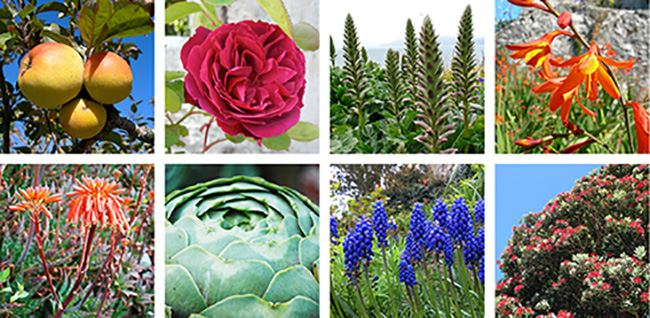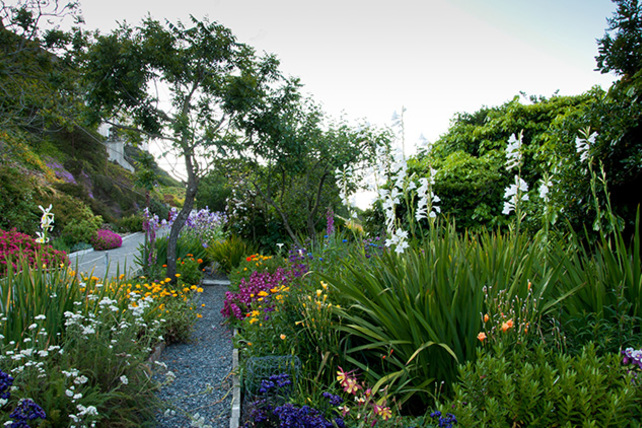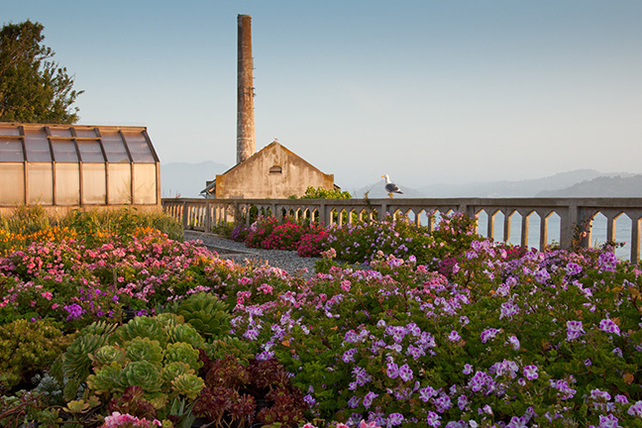Gardens of Alcatraz
For 150 years, a succession of soldiers, families of correction officials, and inmates cultivated gardens hewn on the rocky, windswept island of Alcatraz. For ten years, the Garden Conservancy led the effort to rehabilitate the Gardens of Alcatraz in partnership with the Golden Gate National Parks Conservancy and the National Park Service. In 2014 the restoration project completed successfully. Visitors once again are able to enjoy and gain insight into the role these plantings played in the lives of people who inhabited this harsh environment. The Golden Gate National Parks Conservancy is now managing the gardens locally.
TIMELINE
2021
The Gardens of Alcatraz receive a Garden Conservancy Gardens for Good grant to purchase an all-terrain vehicle for the garden’s horticultural staff and volunteers.
2014
After successful completion of the Historic Gardens Project led by the Garden Conservancy, management of the Gardens of Alcatraz transitions to local management under the Golden Gate National Parks Conservancy.
2010
Volunteers erect new propagation greenhouse in Rose Terrace; greenhouse dedicated to the memory of Carola Ashford. Partnership Project award from the Association of Partners in Public Land.
2009
Shelagh Fritz succeeds Carola Ashford as project manager. Rainwater catchment system installed. The Alcatraz Historic Gardens Project wins two prestigious California Preservation Foundation awards.
2008
The Cell House slope is replanted and the west side gardens begun.
2007
The garden rehabiliation effort receives a Save America's Treasures grant. Officers' Row is replanted.
2006
The rehabilitation of significant planting beds begins with participation of staff and volunteers.
2004
The stabilization of Officers' Row and western terraces commences under the direction of Carola Ashford, a Garden Conservancy Marco Polo Stufano Fellow and later Alcatraz Historic Gardens Project Manager.
2003
A partnership is formed among the Garden Conservancy, the Golden Gate National Parks Conservancy, and the National Park Service to renew the gardens of Alcatraz.  Above: some of the hardy plants that survived four decades of neglect
Above: some of the hardy plants that survived four decades of neglect
1986
Alcatraz is designated a National Historic Landmark.
1972
The Golden Gate National Recreation Area is established, placing Alcatraz under National Park Service management with increased public access.
1969
The island is occupied as part of the American Indian protest movement. Many of the structures are destroyed by fires.
1963
The penitentiary is closed and the island is transferred to the Governmental Services Administration. Although a caretaker stays on, the gardens begin to decline with invasive overgrowth covering many beds and paths.
1940
After most of the officers' cottages are demolished, staff families and inmates plant cutting gardens in the building foundations.
1934
Freddy Reichel, the warden's secretary and an avid gardener, convinces the warden to allow the federal prisoners to garden and seeks advice and plants from prominent California horticulturists. For the next 15 years three inmates in particular, Dick Franseen, Elliott Michener, and Jack Giles, play important roles in developing and tending the west side gardens, the water tank area, and the gardens and greenhouse at the wardens house.
1933
The island is transferred from the military to the Federal Bureau of Prisons.
1924
Using plants and seeds donated by the California Spring Blossom and Wild Flower Association, prisoners plant hundreds of pounds of nasturtium and poppies, shrubs, and 300 trees (eucalyptus, pines, cypress, and giant sequoias).
1912
After construction of a new cell house, inmates build and plant gardens on the island's west side near the guard tower.
1907
The military post becomes exclusively a military prison.
1881
Gardening becomes an important aspect of daily life for officers' families and prison inmates as some of the original gardens give way to a row of officers' cottages, each with its own garden plot.
1861
A military prison is established. Soil is brought in from nearby Angel Island and, along with the dirt, comes seeds of wild blackberry, coyote brush, and blue elderberry. Barley and ice plants are planted to control erosion, and a few gardens are created near what will become Officers' Row. Citadel garden, 1869. Photo: Eadweard Murbridge, Bancroft Library
Citadel garden, 1869. Photo: Eadweard Murbridge, Bancroft Library
1853
U.S. Army establishes fortifications and undertakes construction projects, including the Main Road, on the mostly stratified sandstone and guano-coated island.
For more information, visit alcatrazgardens.org.

Historic Alcatraz Gardens Project
Read the fascinating story of the ten-year project we led to rehabilitate the Gardens of Alcatraz!

The revitalization of the historic gardens of Alcatraz is beautifully captured in Alcatraz Gardens: Remembered, Reclaimed, Reimagined.






